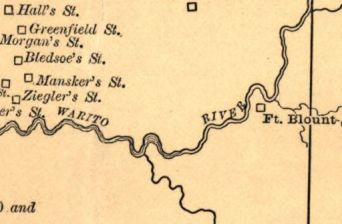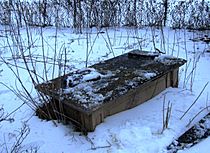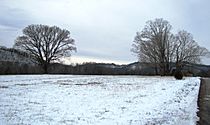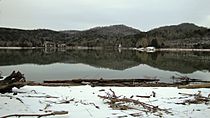Fort Blount facts for kids
Quick facts for kids |
|
|
Fort Blount-Williamsburg Site
|
|
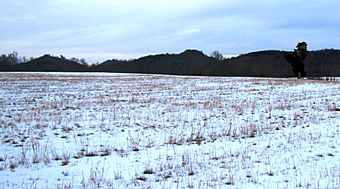
Fort Blount site
|
|
| Location | Jackson County, Tennessee, on the Cumberland River southwest of Gainesboro |
|---|---|
| Nearest city | Gainesboro, Tennessee |
| Area | 125 acres (51 ha) |
| Built | 1787 |
| NRHP reference No. | 74001918 |
| Added to NRHP | July 17, 1974 |
Fort Blount was an important fort and outpost in the wilderness of early America. It was located along the Cumberland River in Jackson County, Tennessee. The fort was built where a key road, called Avery's Trace, crossed the river.
In the 1790s, Fort Blount was a vital stop for people and traders traveling from the Knoxville area to the Nashville area. Around 1800, the fort was no longer used. A town called Williamsburg then grew up on the same spot. Williamsburg was even the county seat for Jackson County from 1807 to 1819. Today, both the fort and the vanished village sites are recognized as historic places. They were added to the National Register of Historic Places in 1974.
The fort was built in 1794. It was named after William Blount, who was the governor of the Southwest Territory. Soldiers from the local militia and later the U.S. Army guarded the fort until it closed in 1798. Between 1989 and 1994, archaeologists dug up the area. They found where the fort was located and learned about its shape.
Contents
Where Was Fort Blount Located?
The Fort Blount site sits on a high bank overlooking the west side of the Cumberland River. This spot is about 340 miles (550 km) upstream from where the river flows into another. Today, this part of the river is part of Cordell Hull Lake.
The bank is at the end of a piece of land shaped like a finger. This land is formed by a sharp turn in the river called Smith's Bend. You can reach the area mainly by Smith's Bend Road. This road connects to Tennessee State Highway 53. It's about 10 miles (16 km) west of Gainesboro.
The old town of Williamsburg was close to the Williams Cemetery. This cemetery holds the graves of an early settler, Sampson Williams, and his wife, Margaret. Williamsburg was about 1,500 feet (460 m) southwest of Fort Blount. The Fort Blount Ferry was at the end of Smith's Bend Road. It connected to the Flynns Creek community across the river. Most of Smith's Bend is still private farmland. However, the Army Corps of Engineers manages some recreation areas along the lake.
The Story of Fort Blount
Building a Frontier Fort
In 1788, the governor of North Carolina ordered a road to be built. This road would connect what is now East Tennessee with Middle Tennessee. It was meant to make it easier for people to travel across the rough Cumberland Plateau. This road was known as Avery's Trace. It crossed the Cumberland River at a natural shallow spot called the "Crossing of the Cumberland." This spot was then on the eastern edge of Sumner County.
In 1791, Sampson Williams was given permission to run a ferry at this crossing. He was an early settler in Nashville and a sheriff.
Growing Tensions and New Forts
After the American Revolution, many settlers moved to Middle Tennessee. This caused more conflict between Native Americans and the white settlers. Attacks by Native Americans increased a lot. So, many small forts, called "stations," were built across Middle Tennessee in the 1780s and 1790s.
In 1792, Governor William Blount told Sampson Williams to gather a group of local soldiers. He also told him to build a blockhouse at the Crossing of the Cumberland. A blockhouse is a strong, small fort. The blockhouse was finished in late 1792 or early 1793. It was sometimes called "Beard's blockhouse." Williams became a lieutenant and led the small group of volunteer soldiers.
In 1794, the Secretary of War, Henry Knox, thought blockhouses were not strong enough. He suggested that Governor Blount replace the blockhouse with a stronger stockade. A stockade is a fence of strong posts. The new fort was completed in 1794 and was named "Fort Blount." Sampson Williams, who also ran a tavern at the ferry, provided food and supplies for the fort's soldiers.
Local soldiers guarded the fort until Tennessee became a state in 1796. Then, Governor John Sevier sent the local soldiers home. The next year, a company of U.S. Army regulars took over the fort. These soldiers guarded the supply routes. They were only there for a few months. By February 1798, Fort Blount was no longer used.
In 1796, a French plant expert named André Michaux was staying at Fort Blount. He discovered a rare tree, the American yellowwood tree, in the nearby forests. The next year, Louis-Philippe, who would later become the King of France, passed through Fort Blount. He said the fort was being changed or replaced. In 1802, Michaux's son, François André Michaux, visited the Williams' tavern. He reported that Fort Blount had been torn down.
The Town of Williamsburg
After the fort closed, Sampson Williams bought most of the land around it. He built a large farm. In 1800, the "Fort Blount" post office opened, with Williams as the postmaster. Until 1805, Williams' land was part of Smith County. The Smith County court met at Williams' tavern several times.
In 1805, the county lines were redrawn. Williams' farm was now in Jackson County. In 1806, the Tennessee government decided to buy 60-acre (24 ha) of Williams' farm. This land would be used to create a county seat, which is the main town for the county government. The town was officially named "Williamsburg" the next year.
Williamsburg had a courthouse and a jail, finished in 1808. It also had a hotel, a general store, and at least five houses. People reached the town using the Fort Blount ferry. However, people in eastern Jackson County complained that the courthouse was too far away. It took them two days to travel there and back. So, in 1818, voters in Jackson County decided to move the county seat to a more central spot. The town of Gainesboro was then started. Williamsburg was no longer an official town in 1820.
What Happened Later
After the county seat moved, Sampson Williams bought the old courthouse. He changed it into a fancy home. He kept running his inn and the ferry. His farm grew to hundreds of acres. After he died in 1841, his son-in-law, Andrew McClellan, took over the farm. When McClellan died in 1850, the farm was put into a trust for his children. They sold the land in 1869 to John Pruett. After Pruett died 10 years later, it went to his daughter Sallie and her husband, James Fox. The land stayed in the Fox family until the mid-1900s. The Fox house, shown on a 1931 map, might have been on the site of the old courthouse. The Fort Blount Ferry kept running until 1974.
In the early 1960s, the U.S. Army Corps of Engineers looked at the area. They were planning to build Cordell Hull Dam. Using old maps and land records, they found a 125-acre (51 ha) plot of land. They believed this was the site of Fort Blount and Williamsburg. In 1974, they put this land on the National Register of Historic Places. However, later research and digs by the Tennessee Division of Archaeology showed that both Fort Blount and Williamsburg were actually just outside the listed area.
Digging Up the Past: Archaeology
Between 1989 and 1994, Samuel Smith led a team from the Tennessee Division of Archaeology. They did a lot of digging at the Fort Blount-Williamsburg site. This site is known as 40JK125. The digs mainly focused on the fort itself. They found the remains of a very old structure from before recorded history. They also found three structures likely connected to Fort Blount. Plus, they found thousands of old items. Their discoveries were shared in a report in 2000.
The biggest structure they found was called "Building 1." It had a 21-foot (6.4 m) by 21-foot (6.4 m) limestone foundation. This foundation once held up a wooden building. The archaeologists figured out this was a blockhouse. They based this on its size, square shape, and how blockhouses were built back then.
Just west of Building 1 was "Building 2." Only a few parts of it remained, mostly a chimney. We don't know for sure what it was used for. But archaeologists thought it might have been a kitchen. A bit northeast of Building 1 was "Building 3." Its foundation measured 13 feet (4.0 m) by 12 feet (3.7 m). They found two old fireplaces and signs that a wooden structure hung over one of them. This suggests it was a smokehouse, used for curing meat.
The team also found clues about an outer wall that surrounded all three buildings. They found holes where posts once stood and lines in the ground where plants grew differently. These clues suggest where the walls of the fort might have been. If their ideas are right, the fort was about 120 feet (37 m) long and 90 feet (27 m) wide.
Very old items found at the site show that people used this spot as early as the Paleo-Indian period. It was used a lot during the Middle Woodland period (around 500 BC to 500 AD). Most of the historical items found were pieces of glass bottles and dishes. Many Spanish coins were also found. These coins were common in Tennessee back then. One coin was from 1781. Not many gun parts or bullets were found. But they did find lead balls, leadshot, and parts of old guns. A pewter button found in Building 1's cellar was from 1800 or later. This means the fort likely stood until at least 1800. The archaeologists also found at least three items that were part of soldiers' uniforms in the 1790s.




